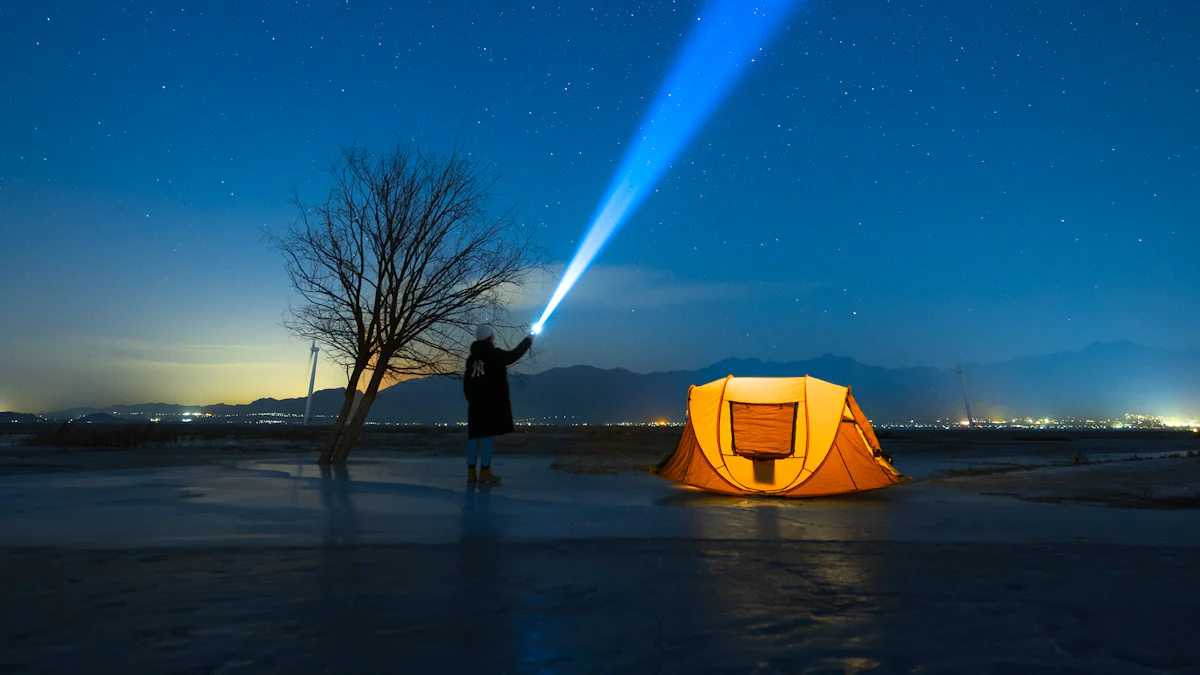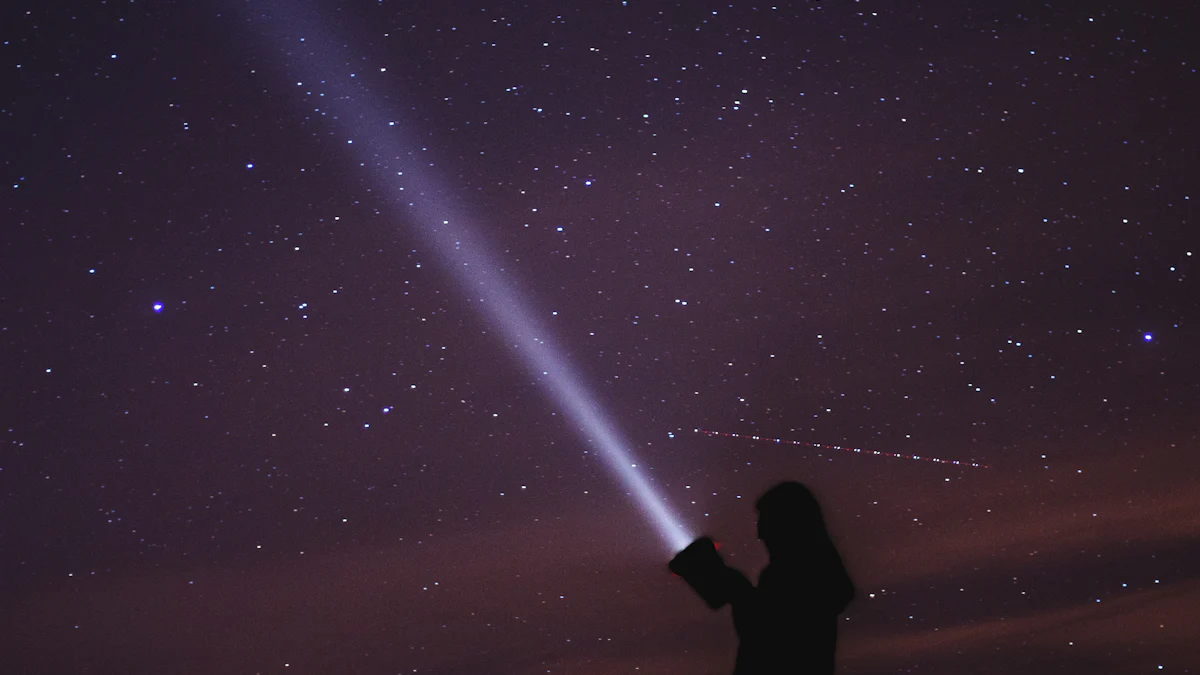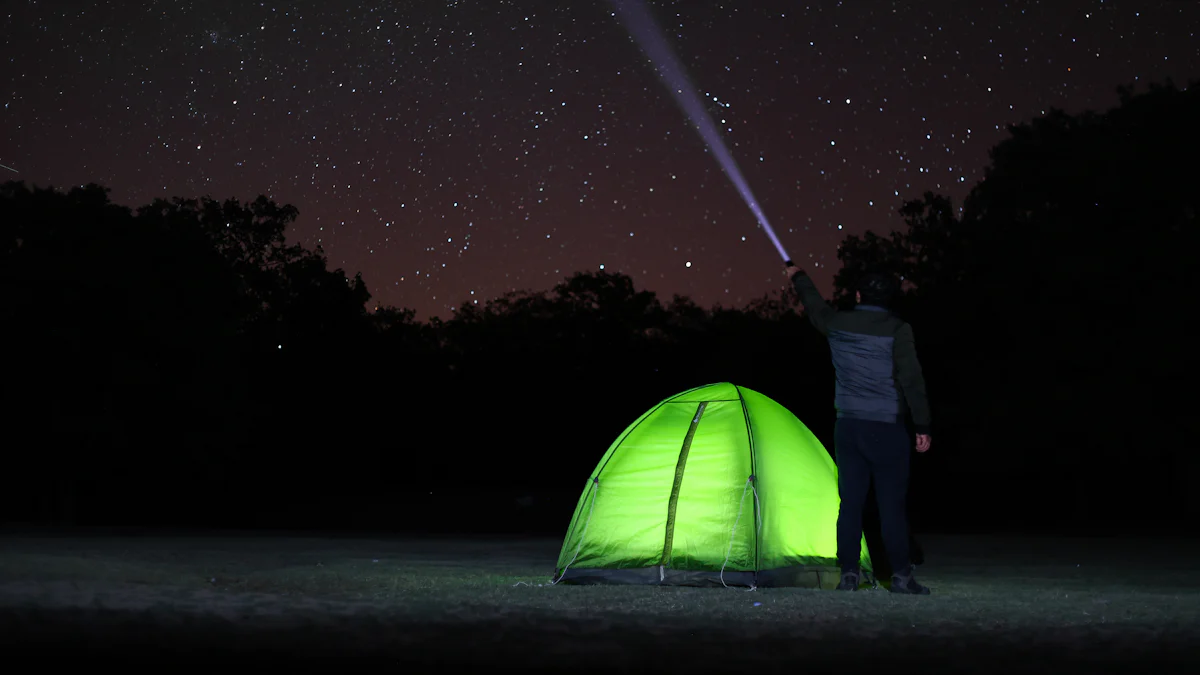How High Lumens Flashlights Can Make a Difference in Outdoor Environments

When you're exploring outdoor environments, a reliable flashlight can be your best companion. High-lumen flashlights, in particular, play a vital role in keeping you safe and prepared. Their powerful brightness ensures you can see clearly, even in the darkest conditions. Whether you're hiking through dense forests or navigating rocky trails, proper visibility can make all the difference.
In fact, high-lumen flashlights are essential in critical situations. Search and rescue teams rely on them for their adjustable brightness and SOS signals. Cavers depend on them to avoid dangerous mishaps in pitch-black tunnels. Even law enforcement and military personnel use them for safety and situational awareness. These examples highlight how high lumens flashlights can make a difference in outdoor environments, ensuring both functionality and peace of mind.
Key Takeaways
Bright flashlights help you see clearly in dark places. They keep you safe while hiking, camping, or exploring outdoors.
Knowing about lumens helps you pick the right flashlight. For camping, use 100-400 lumens. For rescue work, choose 1,000-2,000 lumens.
Get flashlights with brightness you can adjust. This saves battery power and works for different activities.
Take care of your flashlight to make it last longer. Clean it, check for rust, and fix or replace broken parts.
Always bring extra batteries or a charger. This makes sure you have light when you need it outside.
Understanding Lumens in Outdoor Lighting
What Are Lumens?
When you’re shopping for a flashlight or planning your outdoor lighting setup, you’ve probably come across the term "lumens." But what does it actually mean? Lumens measure the total amount of visible light emitted by a source. Scientifically, a lumen represents the luminous flux, or the light emitted through one steradian from a uniform point source with an intensity of one candela. In simpler terms, it’s a way to quantify how bright a light source is.
Unlike watts, which measure energy consumption, lumens focus on brightness. This makes them a critical factor when evaluating lights for outdoor use. Whether you’re hiking, camping, or working on a successful outdoor lighting project, understanding lumens helps you choose the right tool for the job.
Why Lumens Are Crucial for Outdoor Activities
When you’re out in nature, proper lighting can make or break your experience. Lumens play a key role in ensuring safety and functionality. Here’s why they matter:
Lumens indicate how much illumination a flashlight or light source provides.
Brightness is essential for navigating trails, setting up camp, or spotting hazards in low-light conditions.
Knowing how many lumens do you need helps you balance performance with battery efficiency.
For example, a flashlight with higher lumens can light up a larger area, making it easier to see obstacles or find your way in the dark. On the other hand, lower-lumen lights are perfect for conserving battery life during extended trips.
Choosing the Right Lumen Level for Outdoor Use
So, how do you decide on the right lumen level for your outdoor lighting needs? It depends on the activity. Here’s a quick guide to help you:
Activity | Recommended Lumens |
|---|---|
Hiking & Camping | 100 - 400 lumens |
Search and Rescue | 1,000 - 2,000 lumens |
Everyday Carry (EDC) | 50 - 200 lumens |
Tactical and Military | 800 - 2,000 lumens |
For general outdoor lighting, a flashlight with 100-400 lumens is usually sufficient. However, if you’re involved in search and rescue or tactical operations, you’ll need something much brighter. Choosing the right lumen rating ensures you’re prepared for any situation.
By understanding lumens in lighting, you can make smarter decisions for your outdoor adventures. Whether you’re planning a camping trip or working on lumens in your outdoor lighting project, the right brightness level can make all the difference.
Benefits of High-Lumen Flashlights in Outdoor Environments

Enhancing Safety and Visibility
Navigating in Darkness
When you're outdoors at night, darkness can feel overwhelming. A high-lumen flashlight cuts through the blackness, giving you the confidence to move safely. Whether you're hiking on a rugged trail or setting up a tent after sunset, the right lighting ensures you can see every step. Search and rescue teams often rely on these flashlights to illuminate vast areas, making it easier to locate people in need.
Avoiding Outdoor Hazards
Outdoor environments are full of hidden dangers. Rocks, roots, and uneven terrain can cause accidents if you can't see them. High-lumen flashlights help you avoid these hazards by providing clear visibility. Police officers and security personnel use them during patrols to stay alert and safe. Campers and hikers also depend on these lights to navigate safely through wilderness areas.
Application | Description |
|---|---|
Search and Rescue | Essential for illuminating large areas or searching through debris in low-light conditions. |
Law Enforcement | Used to enhance visibility during patrols, investigations, and emergency responses. |
Outdoor Activities | Popular among campers, hikers, and hunters for navigation and safety in the wilderness. |
Versatility for Outdoor Activities
Hiking and Backpacking
A high-lumen flashlight is a must-have for hiking. It helps you explore trails with ease, even in low-light conditions. You can choose a flashlight with moderate brightness to conserve battery life during long backpacking trips.
Camping and Exploration
Camping becomes more enjoyable when you have reliable outdoor lighting. A camping flashlight with adjustable brightness can light up your campsite or help you find gear in your tent. It’s also great for exploring nearby areas after dark.
Emergency and Survival Scenarios
In emergencies, a high-lumen flashlight can be a lifesaver. Many models come with SOS signals and multiple brightness levels. These features are invaluable during search and rescue missions or survival situations.
Hiking: Useful for exploring terrain with moderate brightness and long battery life.
Camping: Essential for long-lasting illumination during outdoor activities.
Search and Field Rescue: Multi-output levels for different brightness needs and SOS signals.
Improving Convenience and Functionality
Long-Range Illumination
Sometimes, you need to see far ahead. High-lumen flashlights provide long-range illumination, making them perfect for spotting distant objects or navigating open areas. This feature is especially useful for hunters and night riders.
Adjustable Brightness for Various Tasks
Not every situation requires maximum brightness. Many high-lumen flashlights offer adjustable settings, so you can switch between modes for different tasks. Whether you're reading a map or lighting up a trail, you’ll have the flexibility you need.
Tip: Look for a flashlight with multiple modes to get the most out of your outdoor lighting experience.
How to Choose the Best Flashlight for Outdoor Use
Key Features to Evaluate
Brightness and Beam Distance
When choosing a flashlight, brightness and beam distance are two of the most important factors to consider. Brightness, measured in lumens, determines how much light the flashlight emits. For outdoor lighting, a range of 200 to 1,000 lumens works well for most activities. If you’re hiking or camping, a flashlight with 400 lumens can illuminate trails or campsites effectively.
Beam distance, on the other hand, tells you how far the light can reach. For example, a flashlight with 400 lumens can project light up to 200 meters, making it ideal for hiking or backpacking. If you need a flashlight for emergency rescue or extreme conditions, look for one with a beam distance of 350 meters or more.
Lumens | Distance | Best For |
|---|---|---|
160–400 | Up to 100m | Camping, hiking, backpacking |
400–1000 | Up to 200m | Hiking, caving, campervan engine repair |
1000–30000 | Up to 350m | Fishing, hunting, rock climbing |
Battery Life and Power Options
A good flashlight should have a reliable battery life, especially for extended outdoor trips. Rechargeable batteries are a great option since they’re eco-friendly and cost-effective. If you’re camping or hiking for several days, choose a flashlight with long-lasting power to avoid running out of light when you need it most.
Durability and Weather Resistance
Outdoor environments can be tough, so your flashlight needs to handle the elements. Look for one made from durable materials that are waterproof and impact-resistant. A quality flashlight with an IPX rating ensures it can withstand rain or accidental drops, making it a dependable choice for outdoor lighting.
Additional Features for Outdoor Lighting
Adjustable Modes and Settings
Flashlights with multiple modes give you flexibility for different tasks. For example, a low mode conserves battery life, while a high mode provides maximum brightness for emergencies. Some tactical flashlights even include strobe or SOS settings, which are useful in survival situations.
Portability and Compact Design
Carrying a bulky flashlight can be inconvenient. A compact and lightweight design makes it easier to pack and carry during outdoor adventures. Whether you’re hiking or camping, a portable flashlight ensures you’re always prepared without adding extra weight to your gear.
Matching Flashlights to Outdoor Needs
To find the best flashlight for your needs, think about how you’ll use it. For hiking, prioritize a flashlight with a focused beam and at least 200 lumens. If you’re camping, choose one with long battery life and a wide floodlight for illuminating larger areas. For emergencies, look for tactical flashlights with multiple modes and durable construction. Matching the flashlight’s features to your specific activities ensures you’ll have the right tool for any situation.
Tip: Always test your flashlight before heading outdoors to ensure it meets your lighting needs.
Practical Tips for Using High-Lumen Flashlights Outdoors

Extending Battery Life
When you’re outdoors, the last thing you want is a dead flashlight. To make your batteries last longer, store your flashlight in a cool, dry place when not in use. Extreme temperatures can damage both the flashlight and its batteries. If you’re heading out in cold weather, keep your batteries warm by storing them close to your body. Lithium batteries are a great choice for cold conditions since they perform better than standard ones.
Switching to rechargeable batteries is another smart move. They’re reliable, eco-friendly, and reduce waste. Just make sure to use the correct charger for your battery type and avoid overcharging. Chargers with automatic shut-off features can help with this. Also, don’t let lithium-ion batteries fully drain—recharge them before they’re completely depleted. For long trips, carry spare batteries and remove them from the flashlight if it won’t be used for a while.
Maintaining Your Flashlight
Proper maintenance keeps your flashlight working like new. Start by cleaning it regularly. Wipe down the exterior to remove dirt and grime, and clean the lens to maintain brightness. Don’t forget to check the battery housing for corrosion. If you notice cracked or dried-out O-rings, replace them to keep the flashlight waterproof. Lubricating the threads and O-rings every six months ensures smooth operation.
It’s also a good idea to inspect your flashlight’s seals and apply grease if needed. This protects against moisture, especially during camping trips or rainy hikes. Test all functions periodically to catch any issues early. A little routine care goes a long way in extending the life of your outdoor lighting gear.
Using Flashlights Safely in Outdoor Settings
High-lumen flashlights are powerful tools, but they require careful handling. Never shine the light directly into someone’s eyes—it can cause discomfort or even temporary blindness. If your flashlight gets hot during use, lower the brightness to prevent overheating. Many high-lumen models include a lock-out mode to avoid accidental activation, so use this feature when storing your flashlight in a bag or pocket.
Always handle batteries with care. Rechargeable batteries should be properly maintained to ensure safety and longevity. If you’re using your flashlight for extended periods, take breaks to let it cool down. These simple precautions will keep you and your flashlight safe during any outdoor adventure.
High-lumen flashlights truly shine when it comes to outdoor safety and convenience. They’re indispensable for activities like camping, hiking, and fishing, offering reliable lighting to navigate trails, set up tents, or cook meals in dim conditions. Whether you’re exploring caves, diving, or involved in search and rescue, these flashlights provide the brightness and versatility you need to stay safe and prepared.
When choosing a flashlight, think about your specific outdoor needs. Do you need long-range illumination for hiking or adjustable brightness for camping? Matching the flashlight to your activities ensures you’ll get the most out of your lighting gear.
To maximize effectiveness, always carry extra batteries or a power bank. Use adjustable settings to conserve power and consider hands-free options like headlamps for added mobility. Managing battery life and using lower brightness modes can also extend your flashlight’s runtime. With these tips, you’ll see how high lumens flashlights can make a difference in outdoor environments, ensuring every adventure is well-lit and worry-free.
FAQ
What makes a flashlight "high-lumen"?
A flashlight is considered high-lumen when it emits 1,000 lumens or more. This level of brightness provides powerful illumination, making it ideal for outdoor activities like hiking, camping, or search and rescue missions.
How many lumens do I need for camping?
For camping, 100 to 400 lumens usually work well. This range offers enough brightness to light up your campsite without draining the battery too quickly. If you’re exploring trails, consider a flashlight with 400 lumens or more.
Are high-lumen flashlights safe to use?
Yes, but you should handle them carefully. Avoid shining the light directly into someone’s eyes, as it can cause discomfort or temporary blindness. Use lower brightness settings for close-up tasks to prevent overheating.
Can I use rechargeable batteries in my flashlight?
Absolutely! Rechargeable batteries are eco-friendly and cost-effective. They’re perfect for outdoor adventures, especially when paired with a portable charger. Just make sure your flashlight supports rechargeable batteries before using them.
What’s the best way to maintain my flashlight?
Keep it clean and dry. Wipe the lens and exterior regularly, and check for corrosion in the battery compartment. Replace worn-out O-rings to maintain waterproofing. Lubricate threads every six months for smooth operation.
Tip: Test your flashlight before every trip to ensure it’s working properly.
See Also
Benefits of XHP360 LED Flashlights for Bulk Purchasers
Understanding Lumens and Brightness When Selecting Flashlights
Finding the Ideal Flashlight or Headlamp for Outdoor Activities
Comprehensive Guide to Bulk Flashlights: Brightness and Strength
